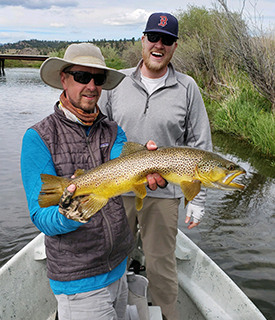Drought Guidelines
FOAM
Drought Angling Guidelines
We developed these guidelines long ago with MT Fish, Wildlife & Parks, and MT Trout Unlimited. Keep them in mind when guiding or fishing during drought.
- Be honest with your clients about the very real possibility of drought conditions.
- If possible, book clients earlier in the season; avoid August and September dates.
- When conditions warrant, cancel and/or rebook clients; take the long view on your business success.
- If you’re forced to travel outside your ‘home’ waters due to fire or drought closures, be sure to respect local etiquette and techniques.
- If you find transplanted outfitters and guides in your area, recognize that they are trying to serve their clients just like you are; respect their needs and offer your hospitality.
- Reduced flows concentrate fishing, so be patient at put–ins and take–outs.
- Take your clients to less drought-affected waters such as secondary streams, private spring creeks and ponds, public lakes and reservoirs. Make sure you have the waters in your operations plan and obtain the appropriate permits or permission to be on them.
- Use cooler stretches or start earlier to avoid rising water temperatures.
- If possible in your area, target warm-water species such as carp, pike, perch, or golden–eyes. Make sure your anglers have warm–water species stamps.
- Ask them to limit the number of fish they catch and release.
- Use heavier gear and tackle to land fish quickly.
- Show them how to land and release fish quickly; use caution when doing so:
- Pull the boat over to release fish; the closer to their original ‘hole’ the better.
- Use a landing net with a rubber net–bag
- Keep the fish in the water as much as possible; this summer, skip the photos!
- In general, salmonids prefer temperatures in the range of 54° F. to 63° F.
- In general, some species are a little more tolerant of higher temperatures than others; or, in some areas local populations of a particular native species can be more tolerant of higher temperatures than the same species elsewhere. But this occurs only after generations of adaptation (for example, redband trout of the Great Basin are more tolerant of higher temperatures than redband trout found in the upper Columbia basin).
- In general, salmonids can adapt more easily to higher temperatures if the temperature increase occurs gradually. Sudden elevations of temperatures can cause acute fish kills.
- In general, high temperatures might not cause direct mortality. However, it can compound the effect of other stressors, such as disease or energy depletion resulting from competition and catch-and-release angling.
- Dissolved oxygen can be reduced when water temperatures rise. Depending on water temperatures, ideal dissolved oxygen concentrations for active fish can be around 10 parts per million (ppm) or higher. When levels of dissolved oxygen drop below 6 parts per million, trout become stressed. Feeding, predator avoidance and sustained swimming becomes difficult. Below 4 ppm, trout can die. Dissolved oxygen levels in the Clarks Fork at night during the summer have been recorded below 6 ppm.
- In general, depending on species, once temperatures rise above the mid–60’s F., trout can start feeling the adverse effects of high temperatures. Feeding will be reduced. Sustained swimming becomes more laborious. The ability to compete with other species for common food sources is reduced once temperatures approach the 70’s. Higher temperatures can affect equilibrium. Lethal temperatures, depending on species, range from 74° F to 79° F. However, it’s possible for trout to survive at these temperatures if they locate cool thermal refuges, or if these high temperatures are moderated by drops in temperature at night.
- There are no hard and fast criteria that definitely determine when it’s okay to fish and when it’s not. But anglers should be cautious handling trout when water temperatures reach the mid–60’s. It’s wise to consider avoiding waters where temperatures reach 70° F. or more each day during a sustained period. Watch fish behavior after you release them. If they’re sluggish or seem slower to recover than usual, they could be stressed from the effects of high temperatures.
- (Thanks to Montana Trout Unlimited for these guidelines)
- People suffer during the hot days that accompany drought, too. Bring water and sunscreen and don’t underestimate the value of a mid-day nap or short swim.
- No barbecues, matches, smokes, or open flames during times of extreme fire danger, and avoid parking your rigs on dry grass.
- Ranchers suffer right along with us, so show appreciation to those who reduce irrigation to provide in–stream flow.
- Low water dries up prairie potholes, too, and waterfowl are forced to nest on mainstream waters, so be careful around islands and other potential nesting areas.
- Low water means higher concentrates of pollution in watersheds, so be vigilant and report any sources of toxic runoff to the Department of Environmental Quality.

